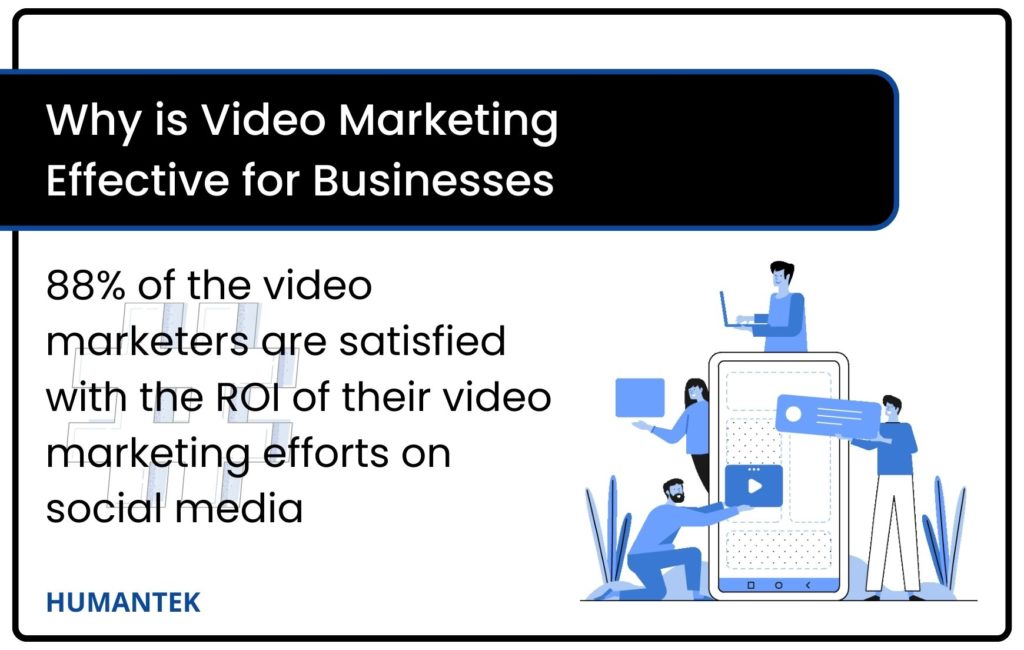7 Steps to Create an Effective Video Marketing Strategy
Humantek team
July 5, 2022
Now is the moment to start video marketing if you haven’t already. With traditional marketing’s effectiveness falling and video’s popularity growing, video marketing strategy has become a must-have for any enterprise.
Social media strategy has been elevated thanks to video marketing. Video is an effective medium because it allows you to engage emotionally with your target audience. Creating an emotional connection with someone is what makes them want to conduct business with you. The odds of gaining a new consumer are greatly increased by establishing likability and trust.
By 2022, online videos will account for more than 82 percent of all consumer internet traffic, indicating that video is a digital marketing trend that is here to stay (Cisco).
“In this blog, brought to you by a top-rated video marketing company, you will learn everything you need to know to jump ahead first into video marketing. Start at the beginning and work your way to the end if you’re new to video marketing. Alternatively, pick and choose the sections that are perfect for you if you’re here to improve your talents and take your video marketing to the next level.
Why Video Marketing is Important?

Source: blog.hubspot.com
The face of video advertising has shifted; one minute of video is worth 1.8 million words.
Every day, around 100 million internet users watch online videos.
64% of video marketing viewers go on to buy something.
Every second, four new people join social media.
Every day, Facebook users share nearly 4 billion items.
It’s a new style of advertising that’s quick, effective, and worldwide.
What is Video Marketing?

Why is Video Marketing Effective for Businesses?

Source: www.oberlo.com
Six out of ten customers, according to Google’s research, would prefer to watch web videos than watch television
YouTube claims that its viewers watch more than 1 billion hours of video every day.
According to a recent survey by Aberdeen, a research and analytics company, businesses that use video generate 49% more income than those that don’t. While video used to be primarily a marketing tool, it has since developed into much more. Videos, with their ability to graphically explain and display things and concepts, can assist businesses in not only showcasing their products and services and attracting new clients but also in attracting new employees and making the work environment more productive.
The value of video marketing strategies has risen by leaps and bounds in recent years. The strategy behind your video marketing is just as vital as the execution. Whether you’re new to video or have been using it for years, you’ll need a detailed plan to help you understand what it’s all about. Also, how you intend to assess progress and where you intend to go.
To create an effective social media video marketing strategy, follow our 7-step guide.
How to Build a Video Marketing Strategy?
1. Goals and Targets
The easiest method to define the goal of your marketing video is to figure out where it fits into the marketing funnel.
Video is beneficial at every level of the marketing funnel from awareness at the top, consideration in the middle to conversion at the bottom. Let’s look at this stage in more detail.
• Awareness: Top of the funnel
If you’re creating an awareness video, you should set goals that are tied to brand discovery rather than sales. Total views, 3-second views, and view duration are all good indicators of success.
• Consideration: Middle of the funnel
You build longer engagement and trust-based connections with your already-captured audience in the middle of the funnel. useinsider.com
The click-through rate is the most important metric to consider while producing consideration videos, followed by view length. The click-through rate tells you how many people were interested enough in your video to go to your website or other content. View length is a secondary metric that helps authenticate your viewers’ degree of engagement.
Consideration of content is extremely important for increasing your YouTube subscriber count and other video platform followers.
• Conversion: Bottom of the Funnel
Obviously, the most critical metric for your conversion videos is sales. The click-through rate is another important metric to monitor. You may have a gap between your advertising and your actual product if people are clicking but not buying.
2. Decide on Your Platforms
If you’ve never used video before, start with the platforms where you already have a following. According to data collected by Statista in February 2019 (www.statista.com ), users on Instagram, Facebook, and Snapchat spend over half of their time on the platforms watching videos.
Because videos are so popular for marketing, there is a need for dependable and flexible websites that allow users to upload videos quickly and securely. Because there are so many options and the list is so long, we’ve compiled a list of the top video-sharing platforms available right now to save your time and help you to select the best option.
• YouTube
As the internet’s demand for video grows, Google responds by expanding query diversity, or the number of different search result categories that appear in an index. This implies that instead of just website links, you’re more likely to encounter a range of videos in your search results. To put this in context, YouTube videos frequently appear in the top ten search results on Google, even if they aren’t the most popular.
• Vimeo
• Twitch
The website is absolutely free to use, with the exception of optional premium extras that can help you and your viewers have a better streaming experience.
It can be difficult to keep track of all of the different video formats available on the site. But it’s also given marketers new tools to tell stories and reach their target audiences.
3. Select Your Video Type
Here are some examples of different sorts of videos and their benefits.
• Educational Videos
• Behind-the-scenes
• Interviews
• Video Advertisements on Social Media
• Testimonial Videos
4. Video Content Planning
In the long term, a strong content production strategy will save time and money. Whether you plan with a flowchart or pen and paper, you must understand how films are made and filmed.
Following are some important elements of video content planning.
- • Identifying the necessary props and equipment
- • Script writing
- • Script revisions
- • The video’s storyboard
- • Organizing the shot for the finest results. Mostly, filming will be non-linear.
- • Bringing the right individuals together to be featured.
- • Choosing the locations where you’ll shoot and factoring in natural light for scheduling.
- • Determining where the modified footage should be sent
- • Deciding who will sign off on each step’s approvals. For example, you should check that the script sounds good and matches your voice.
- • Ensure that the music you’re using is allowed to use.
5. Have a Good Knowledge of Post Production
While all components of filmmaking are important, post-production is a critical step in the development of any movie or film. This editing technique has the ability to bring any film to its full potential, ensuring that it connects with the audience.
6. Schedule and Promote the Videos
Multiple videos could be created from a single filming session. Different footage might be patched together to make new videos or used for promotion. Consider the possibilities when it comes to video promotion.
Using a social media management platform that includes YouTube publishing options such as category, tags, playlist and privacy settings can save your time if you are promoting your video to various social networks.






